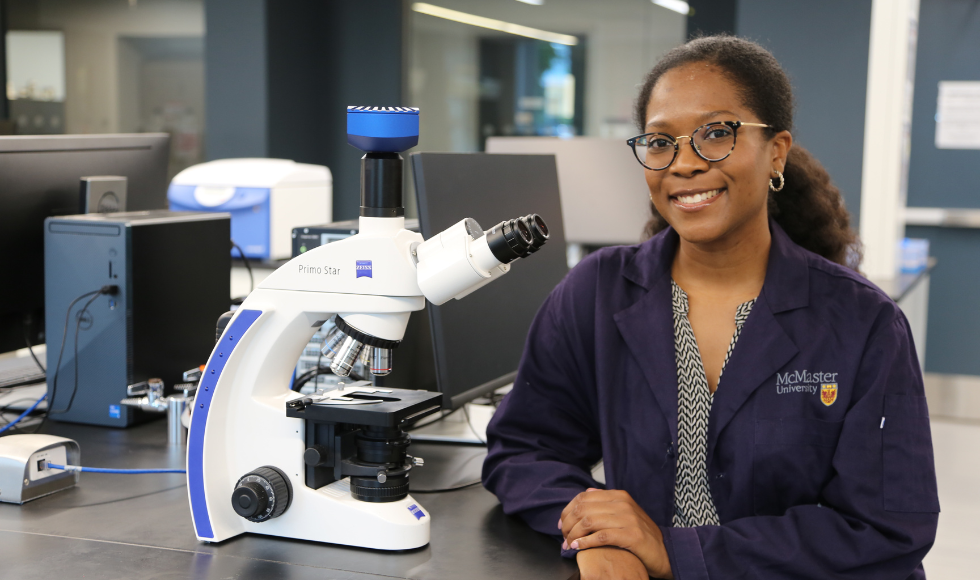Turning a lab into an escape room just one of the ways Shaiya Robinson engaging future scientists

Shaiya Robinson, an associate professor in the School of Interdisciplinary Science, turned two labs into an escape room to engage Black teens in a hands-on workshop on chemistry and genetics.
Shaiya Robinson could’ve recycled a PowerPoint and called it a night after a long day of teaching and holding office hours.
She’d offered to run an introductory chemistry and genetics workshop for visiting high school students.
Mailing it in isn’t in Robinson’s DNA and she believed the teens deserved more than a standard lesson in chemistry. So, Robinson pulled an all-nighter and came up with a plan to turn a pair of Life Science Living System Laboratories into an escape room.
Her Crime Scene Investigators Mystery Workshop had students race against the clock and use forensic science to solve riddles and puzzles and open hallway lockers for more clues. Waiting at the end of the workshop was an online quiz, with prizes on the line. Students ran from to station to station the entire time.
The hands-on workshop was a hit with the teens — having them sit through a PowerPoint deck would’ve been a definite miss. “The feedback was really positive,” says Robinson, an assistant professor in the School of Interdisciplinary Science. “It got them thinking like scientists in a fun and challenging way.”
The students were with Mac-ISTEP – a joint outreach initiative of the Faculties of Science and Engineering. Black students from Hamilton and Halton high schools were welcomed into labs every other week throughout the winter term for hands-on learning. They were back at Mac this summer for a week-long intensive program where students stay in residence for the full university experience.
Enrolment more than doubled to 44 students in the program’s second year. “Word got out,” says Robinson, who designed the program with Biology professor Juliet Daniel, and Lindsay Bolan and Leah Rosenthal from the Faculty of Engineering.
Along with seed funding from McMaster’s Strategic Excellence and Equity in Recruitment and Retention program, Mac-ISTEP is part of Securing Black Futures: A National Partnership to Advance Youth Academic & Career Success. It’s a Canada-wide initiative led by professor Carl James at York University and funded with a $1.2 million donation from the RBC Foundation. McMaster and other universities are running outreach programs focused on different disciplines, sharing ideas and insights and comparing outcomes.
The Mac-ISTEP program gives teens a chance to meet Black faculty and students — people they may seldom see in their high schools or on social media feeds.
That was Robinson’s experience. Of all her teachers and professors from kindergarten to graduate school, only three were Black.
There was Yola Stephens at Fisherville Junior High in Toronto — her parents had moved to Canada from the Caribbean. “Ms. Stephens was a super-nerdy teacher with a love for science — I wanted to be just like her,” says Robinson. “I’d pretend that I didn’t know how to speak French so I could spend extra time getting help and hanging out in her classroom during lunch.”
There was Mireille Stapleton at Newtonbrook Secondary, a Black dance teacher of Trinidadian descent.
And then there was Daniel, Robinson’s PhD supervisor at McMaster. They almost didn’t meet — Robinson was seriously considering teacher’s college. She was tired of being the only Black woman in too many of her undergraduate and graduate science courses. Those courses never addressed or acknowledged scientific racism. Robinson wasn’t sure she could read another paper or sit through another lecture where science had been co-opted to justify or excuse racial inequality.
Daniel had joined McMaster as an assistant professor in November 1999, becoming the first Black female faculty member in Science. She’d remain the one and only Black female faculty member until Robinson was hired nearly 22 years later as an assistant professor in 2021. They’d work together to launch Mac-ISTEP.
Heading up targeted outreach projects is often part of the “tax” paid by faculty from underrepresented groups. Along with being excellent in teaching, research and scholarship, there’s an expectation they’ll make the time to serve on EDII committees and task forces, draft and review policies and be the go-to source for non-racialized colleagues who have questions and confessions. Those same colleagues are free to focus entirely on advancing their careers.
Robinson says the McMaster students in her courses — last year there were around 650 undergrads — will always remain her first priority. “I’m not compromising academic rigour in any of my courses to free up time for outreach.”
Instead, she stretches out her days and works through nights and weekends to plan outreach activities like escape rooms for the next generation of future scientists. She’s also addressing scientific racism head-on in her courses and encouraging her students to further hone their critical thinking skills.
The extra hours are worth it, says Robinson — outreach initiatives like Mac-ISTEP engage Black youth and get them excited about careers in science, technology, engineering and math. “That’s important work — I want Black teens to know they belong in science, they’re welcome at Mac and there are people here who look like them.”
Robinson says she feels a responsibility to give back to her community, just like her middle school teacher giving up her lunch hour to mentor an equally super-nerdy preteen with a passion for science. “It meant everything to me when I was a student to have role models like Ms. Stephens, Ms. Stapleton and Dr. Daniel. I’m not someone who’s going to pull the ladder up behind me as I become established in my career.”
Or mail it in with a recycled PowerPoint presentation.


